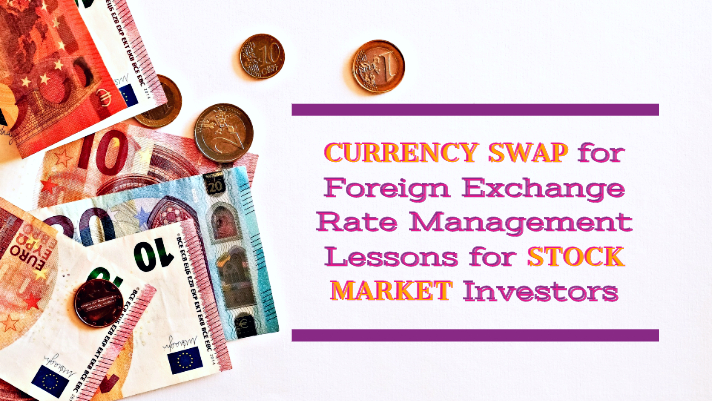Published : December 24, 2018

An economy moves in a cycle, also the stock market obeys similar kind of pattern. For economy, there are growth and recission phases. Likewise in the stock market, there is bull and bear phase. For any stock market player, it is very crucial to determine the phase of the stock market. Or what trend it is going to follow in the near future. Forthwith, there are indicators to convey a sense about the phases of the stock market. Furthermore, some are leading indicators and some are lagging. Bond prices, exchange rate fluctuations, housing statistics, oil prices etc. act as a leading indicator. On the other hand, unemployment rates and consumer price index serves as lagging indicators.
Leading indicators basically signals for the future of any phase. While lagging indicators is one that follows any phase. In fact, it confirms that we are in a particular phase. In the present blog, I will be covering exchange rate fluctuations, which is a leading indicator. I will discuss in particular that how exchange rate fluctuations will time your investment decisions.
The exchange rate shows the relation between one country currency with the other countries’ currencies. Fundamentally, it is the rate at which you will exchange one currency with other. For instance, let us consider the US dollar and Indian rupee. If you want to buy one US dollar then you will need to pay INR 71 in India. So, the exchange rate for USD-INR is 71 per dollar.
Now you might be wondering how this exchange rate has anything to do with stock market trends. The rate at which you exchange one currency for the other does not remain fixed. It changes, and the changes are very fast. These changes in the value of exchange rate give the signal for strengthening or weakening of a particular currency against the other. You are smart enough to keep track of the movement of these changes. This will give you a fair indication of the status of the stock market trend in your country.
You will get to understand this as soon you will complete reading the blog. As of now just keep in mind the following. The value of a US dollar, for instance, is always reflected and caused by interest rates prevailing in the US. These interest rates have a direct connection with stock prices. Therefore, exchange rates affect stock prices and one can also use it to foresee the market.
Before we critique the exchange rate factor, let us know what all factors affect the stock market.
Besides the exchange rate fluctuations, the following are the important factors among others. These also affect the trend in the stock market in India.
Now, comes the most important factor that we will discuss, the exchange rate fluctuations. In some situation, the higher the exchange rate is good for you. While is some low exchange rate turn out to be good. This is because if anyone exchanges currencies, the one will get more of the foreign currency. But how much high is good for the stock market? This question we will address a little later. Presently let us understand why it is good, through an illustration.
Let’s say that you intend to exchange $100,000 into Indian rupees to buy a house. You look at the dollar to rupee exchange rate one day and it is 1.10, meaning you’d get INR 110,000. Then, you look at the exchange rate a week later. It’s risen to 1.120 meaning you’d now get INR 120,000 when you exchange currencies. In this case, a higher exchange rate is better. Because it means you’ll get more Indian rupees to buy your house.
Now let us understand a few other cases of the movement of the exchange rate.
A lower exchange rate can sometimes be better when one wants to sell. Say, for example, if you own a house for 5 years and decide to sell it for INR 100,000. The sale proceeds you want to exchange for the US dollar. In this case, a lower dollar to Indian rupee exchange rate would be better. So you sell your house for INR 100,000 and then transfer the money to the US. Suppose during transferring the exchange rate of 1.20 then you will get $83,333. However, if the dollar weakens to 1.10 versus the Indian rupee, your INR 100,000 will get $90,380. Hence, a lower exchange rate can be good too.
When a nation’s currency is stronger, importing goods from abroad becomes cheaper. To justify this, let’s take an example. Assume the Indian rupee to dollar exchange rate rises from 1.10 to 1.20. It means that you will need to pay less rupee for a dollar. In this case, it becomes much cheaper for India to import those of vehicles or instruments, beverages and other kinds of stuff. In return, the Indian market will observe a price cut on such goods. Taking this as a point, a higher exchange rate is better. Simply meaning it lifts the country’s Global purchasing power.
A lower exchange rate becomes better if the country wants to make their exports cheaper abroad. For instance, say, the UK sterling falls from 1.20 to parity against the INR, at 1.00. Here, the pound has a 20% fall. This means that Indian goods become 20% cheaper for UK customers, thereby driving up sales there. Similarly, suppose that the US wants to accelerate selling goods abroad. So it will need to produce more, helping accelerate other’s economic growth. But for this US needs to keep exchange rate lower. Therefore, lower exchange proves to be better if one wants to boost there export.
In this context, one can easily state that a higher exchange rate is better when there is a buying process. Whereas lower exchange rate is better when it comes to selling.
From the above discussion, we can translate the exchange rate effects on the stock market. In fact, the investors’ portion of equity holdings endangers currency fluctuations. When we concentrate or see foreign currency movements, the sources of company revenues play a vital role. Further, for where the company is based doesn’t matter much.
The higher exchange rate does have a positive effect on companies whose revenue is largely dependent on export. Similarly, it has a negative effect on companies who import most of their raw materials. Higher exchange rate fetches more home currency from exports. While higher exchange rate results in paying more home currency for importing of goods and services.
In contrast, when the exchange rate is low, it is good for imports but impacts inversely on exports. Thus have a positive impact on revenues of companies dependent on imports of raw materials. But companies largely exporting goods and services face the loss of their revenues.
Thus, the stock prices and exchange rate fluctuations are directly dependent on each other. The higher the movement in exchange rate the deeper the effect on stock prices.
The payment of most of the international trade in India is in US dollar. Now let’s focus on few factors about the fluctuation of currency, US dollar, in particular, the on Indian stocks prices –
The fluctuation of the US dollar is in the value against other world’s currencies. And If we talk about equity investors than strong dollars do not always prove to be a good thing. Let us understand this with the help of an example on the majority of revenue from the export of a hypothetical company.
Suppose, an investor buys shares of ABC Company. ABC derives one-third of its revenue from Japan and one-third of India and one-third of United States. Let in a specific quarter, the Indian rupee and Yen tends to be weak against the Dollar. Upon converting revenue in dollar terms, that quarter’s profit has fewer dollars revenue. This will thus, crimp ABC’s overall quarterly profit. Thus, a stronger dollar will translate into price correction of ABC post that quarter result announcement.
A weak dollar can prove to be a boon for the shareholders of a company. I am using the same example as above of ABC Company. Let’s assume that Indian rupee and Yen are strong against the dollar during any quarter. This, therefore, means that it will take less of those currencies to buy more of the greenbacks. Hence in the transaction, ABC will have more dollars. This is possible because of the weakening of the dollar against the Indian rupee and yen.
That particular quarter revenue of ABC will get a boost due to week dollar. Hence, shareholders wealth will get a rise due to the rise in share price post result announcements.
There is always exposure to foreign currency fluctuations, especially against the dollar fluctuations. This is even if the investors buy foreign stocks. This is irrespective of exchanges in India or through ADRs or GDRs on foreign exchanges. Even if you buy any foreign origin company, or trade on indices listed on Indian exchange or other exchange. The fluctuations in the value of the dollar against Indian rupee will affect such trade or stocks investment.
If the dollar makes strong gain against the Indian rupee, demand for imports from India would probably rise. This is because the US buyers would be paying less for them. This plan of action can boost up stock prices of Indian export companies. Simply because it would increase revenues and their products. Accordingly, this will impact the ADRs or GDRs value. Dollar fluctuations do also impact stock prices of foreign listed companies.
it is a fact that the US stocks often appears less volatile than their foreign counterparts. This is so because few foreign currencies are volatile by themselves. The various surveys and studies have additionally shown this. Furthermore, any increase in currency risk means higher portfolio volatility. Hence, hinder an investor’ overall returns.
Here I would like to show a table for average calculation of Indian rupee value. The appreciation or depreciation of rupee against dollar, euro, and pounds over the years. You can also do your own research on RBI currency rate to get an idea of historical currency rate fluctuations on stocks market trends.
| Year | 2011 | 2012 | 2013 | 2014 | 2015 | 2016 | 2017 | 2018 |
| Dollar | 1 | 1 | 1 | 1 | 1 | 1 | 1 | 1 |
| Euro | 0.7729 | 0.7585 | 0.7263 | 0.8227 | 0.9181 | 0.947 | 0.8342 | 0.8821 |
| Yen | 76.9150 | 79.3176 | 104.96 | 119.33 | 120.39 | 116.94 | 112.49 | 113 |
| Indian Rupee | 53.015 | 54.955 | 61.795 | 63.035 | 66.20 | 67.92 | 63.875 | 71.597 |
From 2011 to 2018, the yearly average of currency value is shown in the above table. This denotes that how another country currency fluctuates in comparison to the US dollars. This table would help an investor to get a deep knowledge of their investment plan.
From the above diagram, it is clear that higher USDINR exchange rate did not translate into higher levels in the stock market. I took Nifty 50 as a proxy of stock market fluctuations in India. A higher level of USDINR in between 2014 to 2016 shown consolidation to little dip in Nifty 50 values. Similarly Sharp rise in USDINR value of USDINR from 2017 to 2018 shows consolidation in Nifty 50 values during the period. However, The dip in USDINR value in 2017 from 2016 translates into a sharp rise in Nifty 50 values.
For a live update of currency exchange rate fluctuations, you can visit RBI reference rate page of market intelligence.
The ongoing discussion so far is suggesting that stock market trends depend on exchange rate fluctuations as well. Overall a negative dependency is there on stock market trend and exchange rate movement. It means that if the exchange rate is high, the stock market tends to fall and vice versa. So it is very important for an investor to understand the movement of exchange rates in general to time the stock market investing. Let us understand this is details.
Relatively the purchasing power increases of those countries who have a lower inflation rate. This is shown in rising currency value as compare to other countries’ currencies. The average inflation rate in India in the past 20 years is said to be 3.22% approximately. This does not sound that bad until there is a realization that it would double up in the next 20 years. But prediction not always work. Higher interest rates are charged when a country, say, India has higher inflation as compared to those countries with which it would deal. Then it would be seen that there is a depreciated currency as compared to their trading partners.
There is a co-relation in interest rates, inflation, and exchange rate. Central banks by manipulation of interest rates usually influence inflation and exchange rates both. And the further change in interest rates impacts inflation and currency values. Let’s suppose if a country has higher interest rates. Then it may offer lenders in an economy higher return relative to other countries. Hence, higher interest rates attract foreign capital. This causes the exchange rate to rise. The influence of higher interest rates is alleviated. However, if inflation in the country is much higher than in others, or if additional factors serve to drive the currency down. There is vice-versa relationship exists for decreasing interest rates. That is lower interest rates tend to decrease exchange rates.
If any country is spending more on foreign trading than what it earns is said to be a deficit in the current account. To recover this it will have to borrow capital from foreign sources. This will help make up the deficit. Therefore, the current account is a balance of trade between a country and its trading partners. This reflects all payments between countries for goods, services, interest, and dividends. This situation is often seen for those countries who are said to be developing. And India is one of them. Any country supposes India falls in such situation then the country will need more of foreign currencies. This they achieve through sales of exports and it supplies more of its own currency than foreigners demand for its products.
To pay for public sector projects and governmental funding the country usually get engaged in large-scale deficit. Taking up this scenario, such activity stimulates the domestic economy. Nations with large public deficits and debts are less attractive to foreign investors. The reason behind is large debt encourages inflation and if inflation is high the debt will be serviced and ultimately paid off with cheaper real currency in the future. To pay off debt which can be the worst scenario, a government has to print money and increase in money supply inevitably causes inflation. Moreover, if a government is not able to service its deficit through domestic means (selling domestic bonds, increasing the money supply), then it must increase the supply of securities for sale to foreigners, thereby lowering their prices.
There is a relation between the terms of trade to the current account and balance of payments. Such as a ratio comparing export prices to import prices. Suppose in India the price of export rises by a greater rate than that of its imports. Its terms of trade have favourably improved. Increase in terms of trade reflects in higher demand for the country’s exports. As a result, this would show in rising from exports that provide increased demand for the country’s currency. If there is a rise in the price of exports by a smaller rate than that of its imports, the currency’s value will decrease in relation to its trading partners.
The foreign countries inevitably seek out stable countries. Stable countries with strong economic performance in which to invest their capital. There would be more of political and economic risk when a country with positive attributes will draw investment funds away from other countries. So it is largely a play of stable exchange rate so as to overcome the political and economic risk. The stable exchange rate will also result in economic growth lowering inflationary pressures and hence a prospering stock market.
The exchange rate of the currency which a portfolio holds the bulk of its investments determines the portfolio’s return. There is a decrease in purchasing power of income and capital gains derived from those of any return has a declining exchange rate. Various other important factors get affected by exchange rates such as interest rates, inflation and even capital gains from domestic securities. The exchange rate plays a very significant role in any investment plans because the currency value gets affected by any change in the exchange rate and this will completely be reflected in the rate of return. With this in mind, let us understand the overall macroeconomic effect of exchange rate fluctuations.
It is said to have a direct effect on the consumer price index. As an example, an appreciation of the exchange rate usually reduces the price of imported consumer goods and durables, raw materials and capital goods.
Most of the commodities are seen to be priced in dollars. So we can say that the UK prices of commodities such as foodstuffs and oil have a direct impact on the change in the sterling-dollar exchange rate. Stronger the dollar becomes, more difficult it is to import these items because it becomes more expensive.
Due to the high exchange rate. It becomes more difficult to sell overseas because there is a relatively hiked price. Therefore, if the exports slowdown then the exporters might choose to cut their prices and even tend to reduce the output and cutback the employment levels. Hence, an exchange rate appreciation causes a slower growth of real GDP due to the downfall in net exports and a rise in the demand for imports. It is said to be increased leakage in the circular flow.
Hereby, I would conclude my blog by saying the investors should always try to get the clear picture. A clear picture of what and how they are going to invest in. This is because it is really important to know the factors that will or is affecting their investments.
The stock market investment is highly risky. So a very well known on the factors affecting the stock market trends is a must. The main focus of the current blog was on the exchange rate fluctuations, a major determinant on the trend. Knowing this will help you decide how and when and in which scenario would you will earn the profit. Also, what may lead to your losses for stock market investing.
We explain the currency fluctuations. This will help investors or organizations to know where and how they would get benefits. The stock market has a wide range of benefits and there is no limitation of gains. But there are also chances of losses. If the investors would invest in more than one company stock or shares then they would surely gain in terms of overall profits. The currency value has been proved to be among the most important factor in the exchange rate. This may help the investors decide about timing buying or selling off their holdings
The trading that would deal among different countries such as in terms of imports and exports are can always give any investors a real picture of how and when to invest. I also detailed the impact of imports and exports on stocks investment. Therefore, one should always beware of factors affecting their investment plans. This will help minimize their losses and maximize profits. The investors should always be aware of the movement of currency prices in international as well as the domestic market. Because this would show the gains or losses that one would get from the investment.
Taking into consideration an inflation rate that would help in deciding about the deals with a trading partner. Inflation due to currency depreciation or appreciation can be an important part. The investors should always educate themselves on the interest rates that are on investment. Because the banks would mould the rate of interest according to their influences.
The account deficit has also needed to be taken into consideration because this would show how the country is dealing with its imports or exports saying that for an investment point of the country should not be into deficit because this would always lead an investor to loses. To have the clarity on exchange rate one has to know about stock or stock market and trading off that has already been explained with the help of examples.

Enjoy flexible trading limits at
lowest brokerage rates ?
Open Your Investments Account Now
0Account Opening Charges
Life Time Demat AMC
Brokerage







Ensure the security of your investments by updating your nominee details in your trading & demat account online. It’s quick and hassle-free!
📌 Act Now to Stay Compliant
For assistance, contact our Customer Care at 0562‑4266666 and email askus@rmoneyindia.com.

IT'S TIME TO HAVE SOME FUN!
Your family deserves this time more than we do.
Share happiness with your family today & come back soon. We will be right here.
Investment to ek bahana hai,
humein to khushiyon ko badhana hai.
E-mail
askus@rmoneyindia.com
Customer Care
+91-9568654321